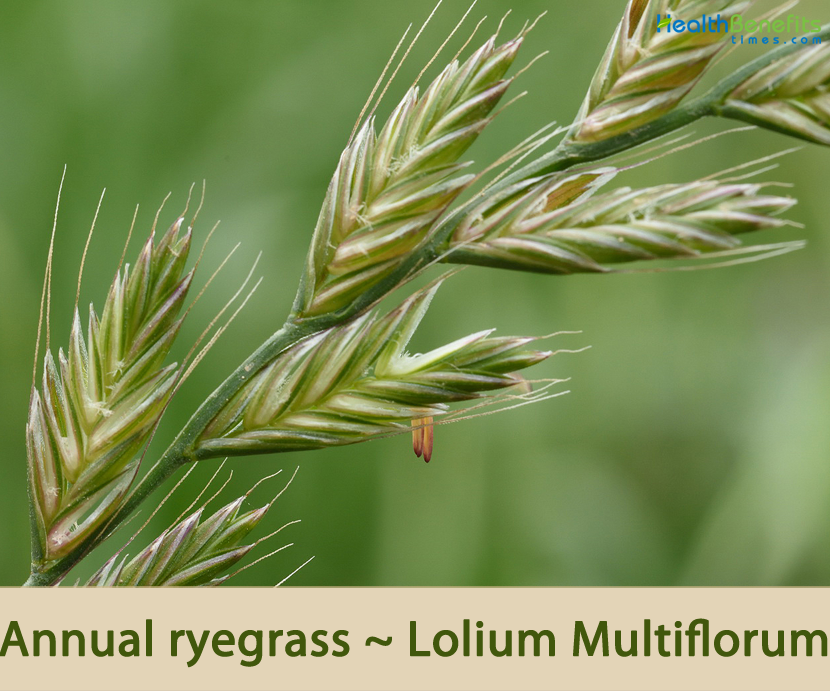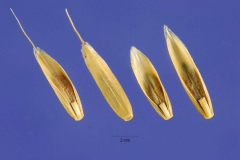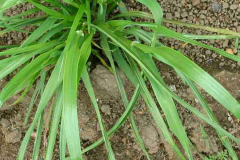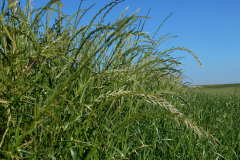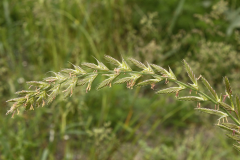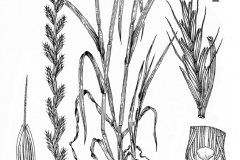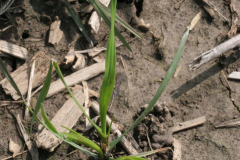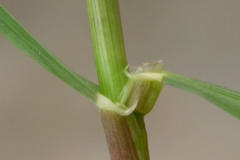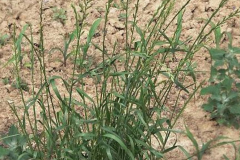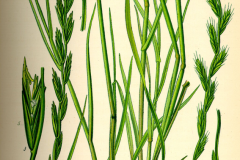It is a perennial grass that is grown for silage, and as a cover crop. It is also grown as an ornamental grass. It has been cultivated and naturalized around the world to help stabilize soils and prevent erosion. However, in fertile soils it can out compete rarer grasses and has spread to waste areas alongside. It readily naturalizes in temperate climates, and can become a noxious weed in arable areas and an invasive species in native habitats. It is a host plant to wheat yellow leaf virus in its native Europe. It is sometimes considered a subspecies of perennial ryegrass. It differs from L. perenne in its spikelet, which has a long bristle at the top, and its stem, which is round rather than folded.
Annual Ryegrass Facts
| Annual ryegrass Quick Facts | |
|---|---|
| Name: | Annual ryegrass |
| Scientific Name: | Lolium Multiflorum |
| Origin | Northern Africa, the Azores, the Madeira Islands, the Canary Islands, southern Europe, western Asia and Pakistan |
| Colors | Straw-colored (Seed) |
| Shapes | Relatively flat, 4-6 mm long, 1 mm wide with the seed embryo often visible through the outer layers (Seed) |
| Name | Annual ryegrass |
|---|---|
| Scientific Name | Lolium Multiflorum |
| Native | Northern Africa (i.e. Algeria, Egypt, Libya, Morocco and Tunisia), the Azores, the Madeira Islands, the Canary Islands, southern Europe (i.e. Albania, Bulgaria, Greece, Italy, Romania, Yugoslavia, France, Portugal and Spain), western Asia (i.e. Afghanistan, Iran, Iraq and Turkey) and Pakistan. It has been introduced into North America, South America, New Zealand, Tasmania, Africa and in adjacent Canadian provinces |
| Common Names | Italian ryegrass, Westerwold ryegrass, Westerwolds ryegrass, annual ryegrass, lovitto ryegrass, Australian ryegrass, short rotation ryegrass, annual Italian ryegrass, rye grass, bearded ryegrass, Perennial ryegrass |
| Name in Other Languages | Afrikaans: Italiaanse raaigras, Italienisches Raigras, Italienisches Raygras, Vielblütiger Lolch, Vielblütiges Weidelgras, Welsches Weidelgras, Westerwoldisches Weidelgras Albanian: Bartalioni, egjri shumëlulesh Arabic: Zawan mutaeadid al’azhar (زوان متعدد الأزهار) Basque: Italiar llollobelar Belarusian: Žycik mnahakvietkavy (Жыцік мнагакветкавы) Brazil: Azevem-annual Bulgarian: Italianski raĭgras (италиански райграс), mnogootkosen raĭgras (многооткосен райграс) Catalan: Raigràs italià, Margall italià Chinese : Duo hua hei mai cao (多花黑麦草), Yìdàlì hēi màicǎo (意大利黑麦草) Croatian: Višecvjetni ljulj Czech: Jílek mnohokvětý Danish: Italiensk rajgræs Dutch: Italiaans raaigras, Italiaanse raaigras English: Annual ryegrass, Italian ryegrass, Westerwold ryegrass, Westerwolds ryegrass, Lovitto ryegrass, bearded ryegrass, Perennial ryegrass Estonian: Itaalia raihein, Mitmeniiteline raihein, üheaastane raihein Finnish: Italianraiheinä French: Ivraie à nombreuses fleurs, Ivraie multiflore, Ray-grass d’Italie, Ray-grass ditalie, Ivraie d’Italie, Ivraie à fleurs nombreuses, Ray-grass italien, Loglio italic, ray-grass multiflore Galician: Herba de Vigo German: Einjähriges Weidelgras, Italienisches Raygras, Vielblütiges Weidelgras, Welsches Weidelgras, Westerwoldisches Weidelgras, Vielblütenlolch, vielblütiger Lolch Greek: Lolio italiko (Λόλιο ιταλικό), Lolio to polianthes (Λόλιο το πολυανθές), Lolio to poliethes (Λόλιο το πολυετές), Lolion to poliethes (Λόλιον το πολυετές), polýanthi íra (πολύανθη ήρα) Hebrew: Zun aitlki (זוּן אִיטַלְקִי) , zun rb-prkhim (זוּן רַב-פְּרָחִים) Hungarian: Olaszperje Icelandic: Einært rýgresi Italian: Loglio italico, Loglio maggiore, Loiessa , Loietto italic, loglietto Japanese: Itarian raigurasu (イタリアンライグラス), Nezumi mugi (ネズミムギ) Latvian: Daudzziedu airene Lithuanian: Gausiažiedė svidrė, gausiažiedė Netherlands: Italiaanse raaigras Northern Sami: Itáliaráisuoidni Norwegian: Italiaraigras, Italiensk raigras Persian: چچم پرگل Polish: Rajgras holenderski, Rajgras włoski, Życica wielokwiatowa Portuguese: Azevém, Azevém-italiano, Ryegrass da Itália, Azevém-annual, azevão, erva-castelhana Russian: Plevel mnogocvetkovyj (Плевел многоцветковый), Rajgras ital’janskij (Райграс итальянский), Rajgras mnogoukosnyj (Райграс многоукосный) Serbian: Italijanski rajgras (италијански рајграс), talijljnski ljulj (талијљнски љуљ) Slovak: Mätonoh mnohokvetý Slovene: Laška ljuljka Spanish: Ballico de Italia , Ballico italiano, Raigras italiano, Raygrass italiano, Vallico de Italia, Azevao, cevolillo, cola de zorro, gran ray-gras, joyo, Ballico, cevolillo, raigras criollo Swedish: Italienskt rajgräs, Italianraiheinä, Borstrepe, Turkish: Italyan çimi Ukrainian: Pazhytnytsya bahatokvitkova (пажитниця багатоквіткова) Upper Sorbian: Wulka motawa Welsh: Rhygwellt Eidalaidd, Rhygwellt yr Eidal |
| Plant Growth Habit | Short, rhizomatous, fast-growing, herbaceous annual, biennial, or perennial cool-season grass |
| Growing Climates | Mesic to moist pastures, grasslands, cultivated fields, Meadows, field margins, roadsides, fruit orchard, upland crop field, weedy field, waste areas and other disturbed sites |
| Soil | Grows on a wide variety of soil types and prefers fertile, well-drained loam or sandy loam soils, but establishes well on many soil types, including poor or rocky soils. It tolerates clay or poorly-drained soils in a range of climates and will outperform small grains on wet soils. It does not tolerate shade for extended periods |
| Plant Size | 3–4 ft. ( 90– 120 cm) tall |
| Root | Fibrous Root |
| Culm | Culm is pale green, terete, glabrous, and unbranched and often purplish at the base |
| Leaf | Alternate leaves are up to 40 cm long and 5-12 mm wide; they are ascending to widely spreading, linear in shape, and rather floppy. The blades are medium green to dark green on both sides, shiny, and hairless. Upper surface is evenly ribbed, lower surface is smooth and shiny. |
| Flowering season | May to September |
| Flower | At the apex of the culm, there develops a floral spike about 6-10″ long, consisting of alternate spikelets along the rachis (flowering stalk). These spikelets are located edgewise along the rachis. The culm often undulates from one spikelet to the next. |
| Lemma | Each lemma is 6-8 mm. in length, linear-elliptic, and convex along its outer surface, where there are several longitudinal veins. The upper lemmas have awns (shorter than the length of the lemmas), while the lower lemmas frequently lack awns. |
| Fruit | Elongated grain |
| Seeds | Seeds are relatively flat, 4-6mm long, 1mm wide and straw-coloured, with the seed embryo often visible through the outer layers |
| Propagation | By seed |
Plant Description
Annual ryegrass is a short, rhizomatous, fast-growing, herbaceous annual, biennial, or perennial cool-season grass that normally grows about 3–4 ft. (90– 120 cm) tall. The plant is found growing in mesic to moist pastures, grasslands, cultivated fields, Meadows, field margins, roadsides, fruit orchard, upland crop field, weedy field, waste areas and other disturbed sites. The plant grows on a wide variety of soil types and prefers fertile, well-drained loam or sandy loam soils, but establishes well on many soil types, including poor or rocky soils. It tolerates clay or poorly-drained soils in a range of climates and will outperform small grains on wet soils. It does not tolerate shade for extended periods. The plants form an extensive, dense root system, even in low fertility and acidic soils, which makes it a good candidate for use for erosion control on sloping fields and grassed waterways.
Leaves
Alternate leaves are up to 40 cm long and 5-12 mm wide; they are ascending to widely spreading, linear in shape, and rather floppy. The blades are medium green to dark green on both sides, shiny, and hairless. Upper surface is evenly ribbed; lower surface is smooth and shiny. The base of each blade is wider than the sheath or the culm, around which there extends a pair of auricles. The leaf sheaths are pale green to pale reddish green, hairless, and longitudinally veined. Young leaves are rolled in the bud. Auricles are small and narrow. Ligule is white, translucent, shorter than wide.
Spikelets
At the apex of the culm, there develops a floral spike about 6-10 inches long, consisting of alternate spikelets along the rachis (flowering stalk). These spikelets are located edgewise along the rachis. The culm often undulates from one spikelet to the next. Each spikelet consists of a single outer glume and 8-20 lemmas with florets. In each spikelet, the ascending lemmas are arranged in 2 overlapping ranks. The glume (8-12 mm. in length) is longer than the lemmas, but shorter than length of the spikelet; it is linear-elliptic, convex along its outer surface, where there are 3-5 longitudinal veins.
Lemma
Each lemma is 6-8 mm. in length, linear-elliptic, and convex along its outer surface, where there are several longitudinal veins. The upper lemmas have awns (shorter than the length of the lemmas), while the lower lemmas frequently lack awns. Each lemma has a single floret with an ovary, 3 stamens, and a pair of feathery stigmata. The blooming period can occur from late spring to fall, but lasts only 2 weeks.
Seed
Seeds are relatively flat, 4-6 mm long, 1 mm wide and straw-coloured, with the seed embryo often visible through the outer layers.
Different Uses of Annual Ryegrass
1. Drought Resistance
Natural hardpan (fraigpan) or manmade compaction prevents corn and soybean roots from getting deep moisture. These soils are found predominately in southern Ohio, Indiana, Illinois, Kentucky and Missouri. Annual Ryegrass grows through and breaks up hardpan, creating macropore channels that corn and soybean roots follow to reach moisture underneath. It will take approximately 4 years (4-6” fraigpan) of continuous no-till with annual ryegrass each year to achieve this. Planting Annual Ryegrass for as little as 2 years in a row may be as effective as running a ripper. In the long run, a cover crop and no-till is a far better strategy for improving soil health and crop yields than conventional tillage.
2. Erosion fighter
Ryegrass has an extensive, soil-holding root system. The cover crop establishes quickly even in poor, rocky or wet soils and tolerates some flooding once established. It’s well-suited for field strips, grass waterways or exposed areas.
3. Nutrient catch crop
A high N user, ryegrass can capture leftover N and reduce nitrate leaching over winter. Provided it survives the winter, its extensive, fibrous root system can take up as much as 43 lb. N/A, a University of California study showed. It took up about 60 lb. N/A by mid-May following corn in a Maryland study. Cereal rye scavenged the same amount of N by mid-April on this silt loam soil. Ryegrass works well ahead of no-till corn or soybeans in the Corn Belt, sometimes winterkilling, or spray it for weed-controlling mulch.
4. Nitrogen Recovery
Growers applying manure are being required to apply manure in a more environmentally friendly fashion. Using Annual Ryegrass could help keep the nitrogen in the soil profile and available for the crop the following year.
5. Soil builder
Ryegrass’s dense yet shallow root system improves water infiltration and enhances soil tilth. Rapid aboveground growth helps supply organic matter. Expect about 4,000 to 8,000 lb. dry matter/A on average with a multi-cut regimen, climbing as high as 9,000 lb. DM/A over a full field season with high moisture and fertility.
6. Quicker Transition to No-Till
When a grower changes to no-till or acquires a farm that is new to no-till, it commonly takes up to 5 years for key soil properties (aggregate stability, organic matter, increased infiltration, pore space, fungi, etc.) to occur. Adding Annual Ryegrass can reduce this transition period by half.
7. Nurse/companion crop
Ryegrass helps slow growing; fall-seeded legumes establish and overwinter in the northern U.S., even if the ryegrass winterkills. It tends to out compete legumes in the South, although low N fertility favors the legume.
8. Weed suppressor
Mixed with legumes or grasses, annual ryegrass usually establishes first and improves early-season weed control. With adequate moisture, it serves well in Hardiness Zone 6 and warmer as living mulch in high-value systems where you can mow it regularly. It may winterkill elsewhere, particularly without protective snow cover during prolonged cold snaps. Even so, its quick establishment in fall still would provide excellent, winterkilled mulch for early-spring weed suppression.
9. Increased Water Infiltration
The extensive and deep root system that Annual Ryegrass develops opens pathways for increased water infiltration.
10. Soybean Cyst Control
Soybean cyst nematodes results in lower soybean yield. Research studies indicate that Annual Ryegrass can (with at least 40 days growing with the soil temperature about 50 degrees) stimulate cyst eggs to hatch in the fall. This results in a very low count, if not elimination, of the nematodes the following year. Fields in the southern half of Illinois, Indiana, Ohio, and Missouri are likely places to benefit, since odds are good that they satisfy the environmental conditions.
11. Emergency forage
Ryegrass is very palatable forage. You can extend the grazing period in late fall and early spring by letting livestock graze cover crops of ryegrass or a ryegrass-based mix. Annual ryegrass can be used as emergency forage if alfalfa winterkills. It establishes quickly and produces a lot of forage in a short amount of time.
12. Grazing
Growers who plant after wheat or corn silage may be able to take a cutting of Annual Ryegrass hay lage in the fall (possibly in the spring, too) and then no-till plant into the Annual Ryegrass. Growers in southern Ohio, Indiana Illinois, Kentucky and Missouri may be able to graze the Annual Ryegrass over winter or take a cutting of haylage in the spring.
Other Facts
- A good green manure crop, it can be sown in autumn or spring and is often combined with clover.
- It may also be grown as a soil stabilizer to prevent or reduce soil erosion and as a species for re-vegetating burnt, degraded or contaminated landscapes.
- In the United States, Lolium multiflorum is occasionally used as a winter cover crop to prevent erosion, build soil structure and suppress weeds.
- As a palatable forage crop, it can be grazed by livestock and provide food in years when alfalfa suffers from winter kill.
Prevention and Control
Due to the variable regulations around (de)registration of pesticides, your national list of registered pesticides or relevant authority should be consulted to determine which products are legally allowed for use in your country when considering chemical control. Pesticides should always be used in a lawful manner, consistent with the product’s label.
Cultural Control
Control of established plants by mechanical or hand weeding will only be effective if complete removal from the soil is achieved, preventing subsequent regrowth. This is generally impractical, although cultivation is able to successfully control small and recently emerged seedlings. In competition experiments between wheat and L. multiflorum, the yield of wheat was increased at higher N fertilizer rates, and when crop density was increased. Cross-sowing of wheat is not an effective means of controlling L. multiflorum.
Chemical Control
In trials in Argentina, pre-emergence applications of trifluralin gave effective control of L. multiflorum, and resulted in increased yield of barley. Clodinafop is recommended for the control of Italian ryegrass up to the three tiller stage and, in trials in Chile, gave good control of a range of annual grass weeds including L. multiflorum only when sprayed at an early growth stage. Oxyfluorfen applied to broccoli crops in autumn gave 69-97% control in the USA. Post-emergence application of metribuzin at the two leaf stage gave good control of L. multiflorum in wheat in Mississippi, USA. In South Africa, 80% control was achieved using triasulfuron in wheat and barley. Propyzamide, fluazifop, chlorsulfuron applied pre-emergence in wheat and haloxyfop-ethoxyethyl have all been used successfully to control L. multiflorum. Mamarot and Rodriguez give recommendations for herbicide use against Lolium spp. in a range of crops, for example, EPTC and atrazine in maize; carbetamide in legumes, rape and sunflower; monolinuron in potato; and a wide range of herbicides related to sethoxydim and fluazifop in broad-leaved crops. In Australia, glyphosate and/or paraquat-based herbicides are used for control of Lolium spp. prior to crop sowing.
Herbicide Resistance
Biotypes of L. multiflorum with evolved resistance to herbicides have been reported in Brazil, Chile, France, Italy, the UK and USA. In the UK, seeds were collected from fields in which diclofop-methyl had failed to control the grass. Glasshouse trials were performed on these accessions to determine their susceptibility to various herbicide treatments. Resistance to diclofop-methyl, fenoxaprop and fluazifop was detected, with some evidence of resistance to traloxydim and partial resistance to isoproturon. Diclofop resistance has also been reported in biotypes from wheat fields in Oregon, USA. These biotypes were susceptible to pre-emergence tri-allate + diuron or post-emergent applications of metribuzin and these have been recommended as alternatives for the control of L. multiflorum. Sulfometuron-resistant biotypes have been reported in Mississippi, USA.
Biological Control
The potential for biological control of L. multiflorum as a weed has not been investigated due to the economic importance of this species as a forage grass.
References:
https://www.itis.gov/servlet/SingleRpt/SingleRpt?search_topic=TSN&search_value=40892#null
http://www.hear.org/pier/species/lolium_multiflorum.htm
https://npgsweb.ars-grin.gov/gringlobal/taxon/taxonomydetail?id=22493
https://pfaf.org/user/Plant.aspx?LatinName=Lolium+multiflorum
https://www.cabi.org/isc/datasheet/31165
http://www.theplantlist.org/tpl1.1/record/kew-422833
https://en.wikipedia.org/wiki/Lolium_multiflorum
https://www.fs.fed.us/database/feis/plants/graminoid/lolperm/all.html
http://biology.burke.washington.edu/herbarium/imagecollection/taxon.php?Taxon=Lolium%20multiflorum
https://gobotany.nativeplanttrust.org/species/lolium/multiflorum/
https://keyserver.lucidcentral.org/weeds/data/media/Html/lolium_multiflorum.htm
https://gd.eppo.int/taxon/LOLMU
https://accs.uaa.alaska.edu/wp-content/uploads/Lolium_multiflorum_BIO_LOMU.pdf
https://www.illinoiswildflowers.info/grasses/plants/it_ryegrass.htm


